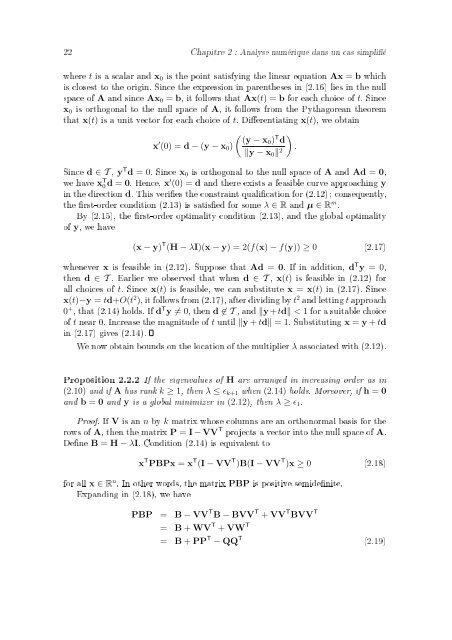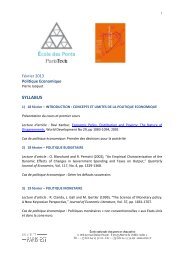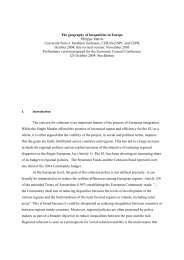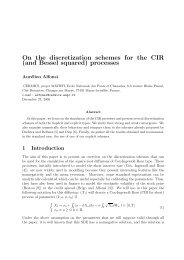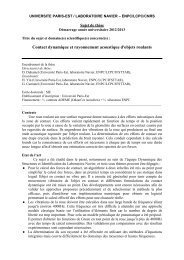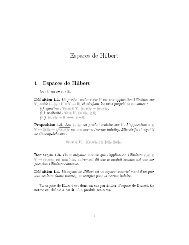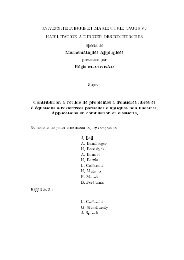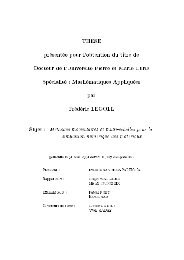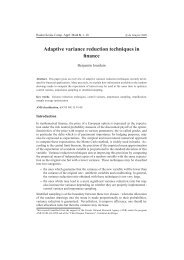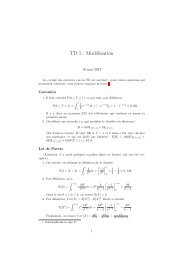Create successful ePaper yourself
Turn your PDF publications into a flip-book with our unique Google optimized e-Paper software.
22 Chapitre 2 : Analyse numérique dans un cas simplié<br />
where t is a scalar and x 0 is the point satisfying the linear equation Ax = b which<br />
is closest to the origin. Since the expression in parentheses in (2.16) lies in the null<br />
space of A and since Ax 0 = b, it follows that Ax(t) = b for each choice of t. Since<br />
x 0 is orthogonal to the null space of A, it follows from the Pythagorean theorem<br />
that x(t) is a unit vector for each choice of t. Dierentiating x(t), we obtain<br />
x ′ (0) = d − (y − x 0 )<br />
( )<br />
(y − x0 ) T d<br />
.<br />
‖y − x 0 ‖ 2<br />
Since d ∈ T , y T d = 0. Since x 0 is orthogonal to the null space of A and Ad = 0,<br />
we have x T 0 d = 0. Hence, x ′ (0) = d and there exists a feasible curve approaching y<br />
in the direction d. This veries the constraint qualication for (2.12); consequently,<br />
the rst-order condition (2.13) is satised for some λ ∈ R and µ ∈ R m .<br />
By (2.15), the rst-order optimality condition (2.13), and the global optimality<br />
of y, we have<br />
(x − y) T (H − λI)(x − y) = 2(f(x) − f(y)) ≥ 0 (2.17)<br />
whenever x is feasible in (2.12). Suppose that Ad = 0. If in addition, d T y = 0,<br />
then d ∈ T . Earlier we observed that when d ∈ T , x(t) is feasible in (2.12) for<br />
all choices of t. Since x(t) is feasible, we can substitute x = x(t) in (2.17). Since<br />
x(t)−y = td+O(t 2 ), it follows from (2.17), after dividing by t 2 and letting t approach<br />
0 + , that (2.14) holds. If d T y ≠ 0, then d ∉ T , and ‖y +td‖ < 1 for a suitable choice<br />
of t near 0. Increase the magnitude of t until ‖y + td‖ = 1. Substituting x = y + td<br />
in (2.17) gives (2.14).<br />
We now obtain bounds on the location of the multiplier λ associated with (2.12).<br />
Proposition 2.2.2 If the eigenvalues of H are arranged in increasing order as in<br />
(2.10) and if A has rank k ≥ 1, then λ ≤ ɛ k+1 when (2.14) holds. Moreover, if h = 0<br />
and b = 0 and y is a global minimizer in (2.12), then λ ≥ ɛ 1 .<br />
Proof. If V is an n by k matrix whose columns are an orthonormal basis for the<br />
rows of A, then the matrix P = I − VV T projects a vector into the null space of A.<br />
Dene B = H − λI. Condition (2.14) is equivalent to<br />
x T PBPx = x T (I − VV T )B(I − VV T )x ≥ 0 (2.18)<br />
for all x ∈ R n . In other words, the matrix PBP is positive semidenite.<br />
Expanding in (2.18), we have<br />
PBP = B − VV T B − BVV T + VV T BVV T<br />
= B + WV T + VW T<br />
= B + PP T − QQ T (2.19)


